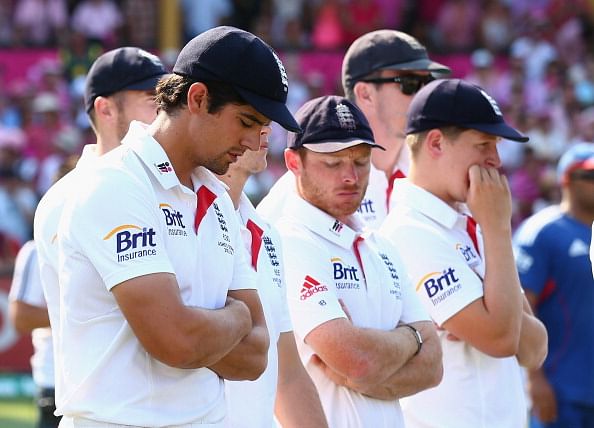
The Ashes 2013-14: The Aussies and the mental game

Did the Aussie mental game destroy Cook and company?
A gloomy and powerless captain, bereft of ideas in the slips and walking back to the pavilion with his head down, after being dismissed, are the lasting images of Alastair Cook from the astonishing Ashes series, after its conclusion in Sydney. Wow, did this relatively new Australian team just whitewash a commanding England team, the number one Test team not too long ago?
The leisure of Test matches allow teams the space to approach the slow grind of five days, and thereby develop their own style of getting through it. Part of the fun of watching the game is the clash between these different approaches taken by teams to achieve similar objectives of taking twenty opposition wickets before letting them overhaul their own net score, after two innings. Australia’s brand has been power and insult. It can be too hot, and even seemingly unpalatable at times, but when they’re not playing to strut their stuff and humiliate the opposition, they’re not at their best, and the appeal goes away.
If an Aussie team can be played around with, it can be a shocking and sorry sight. After Ricky Ponting and Michael Hussey retired at the end of the last Australian summer season, we felt there could be some tough times ahead for the team. For, not only did they have an unsettled line-up as a resultant of those retirements, they had also lost the last link to the Australian team that knew how to eat away at the opposition. When they visited India earlier last year, we saw many things. The explosion in Chennai of MS Dhoni, who isn’t the player most technically adept at passing the test of quality bowling for long innings in Tests, was one. His innings of 224 was a bolt from the blue. One thought, ‘How the hell did that happen? Did he really smash James Pattinson over long off for a six?’
We moved on to the next one: a remarkably quick surrender of Australian batting to Indian spin in the blink of an eye in Hyderabad, where the vulnerability in the eyes of batsmen passing the crowd by as they departed to the dressing room after their dismissals was evident. Michael Clarke’s positive approach was seen in his decision to declare his team’s innings closed at a meagre total – 237 for nine – just to get the tired Indian openers, who were fielding all day, in to face Australia’s bowlers for a tricky few minutes before close of play on the first day. Although the strategy didn’t yield any result, the point was taken: a lack in quality of players wouldn’t allow the mental doors to be remain shut.
The ‘line in the sand moment’, when four Australian players were banned from playing the third Test in Mohali for refusing to hand over‘homework’ to the team management, was another. It was a wound going deeper with time, but knowing Michael Clarke and Australia, this would be hurting. What’s the way out of this deep mess?
Moustache. Keeping one. That’s what former Australian fast bowler Merv Hughes – a man who is known for his facial hair – suggested at the time. The message was to get the mean and powerful style of Australia back. A 4-0 drubbing was suffered in Delhi, despite the moustaches of David Warner and Mitchell Johnson, and the efforts to tamper with the mental equilibrium of Cheteshwar Pujara during his composed innings of an unbeaten 82 in India’s chase of 155 on the third and final day.
But perhaps the message to get mean became overbearing on Warner, who landed a punch to England’s young batsman Joe Root in a pub during the Champions Trophy in England. Australia, on the field, looked like they hadn’t recovered from the scars in India. Something had to give, you felt. Three weeks before the significant Ashes series in England, a change in guard was announced, and a decision was taken to bring in former Australian batsman Darren Lehmann as the coach.
The jokes, smiles and laughter from Lehmann from the visible part of the dressing rooms in England suggested a breezy atmosphere. When debutant No. 11 Ashton Agar played a breezy knock of 98 to rescue Australia from a top-order collapse at Trent Bridge, the signs were encouraging, and though Australia lost the see-saw battle by 14 runs, the attitude shift was evident.
England, however, overpowered Australia in their much-suited disciplined and attritional way at Lord’s. Fast bowler Ryan Harris’ addition to the line-up revved up the bowling, but the quality of Stuart Broad, James Anderson and spinner Graeme Swann made life difficult for their top order. The difference between the sides came to the fore; the series would adopt its normal course, it was thought, and that Trent Bridge was only an aberration.
But it was Lord’s that proved to be the aberration. The Test at Old Trafford was dominated by Australia, led by Clarke’s 187 that helped his team gain a first-innings lead of 159 runs. To wrap up the game, they needed time, however, and rain forced them to abandon the game with England having been knocked down, struggling at 37 for 3 chasing a stiff 332. Australia weren’t so much bullying the opposition, as much as outperforming them by discipline and confidence, the same ingredients as England. The next two Tests at Chester-le-Street and The Oval also saw the two sides indulging in a battle of discipline and concentration. Only, a phase of disarray cost the visitors a defeat in one match, and the unavailability of time disallowed them a peek at victory in the other.